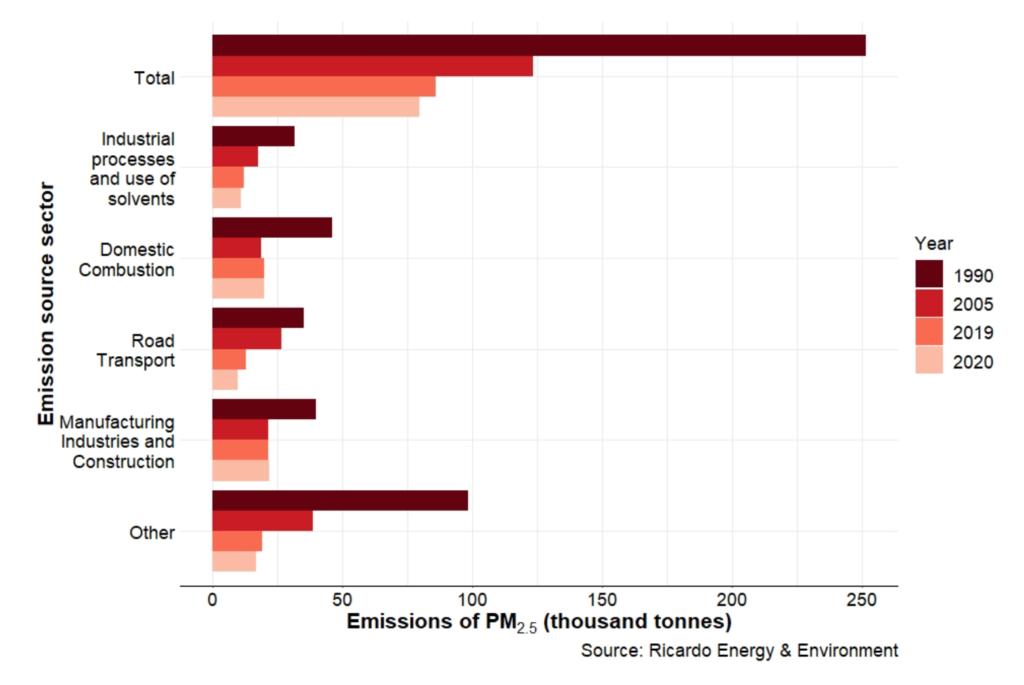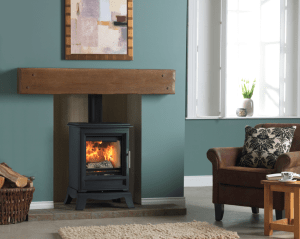According to a government report, the overall percentage of PM2.5 emissions linked to domestic burning of wood indoors has been halved to 17%. This revision in figures is thanks to more accurate wood fuel usage data for the domestic combustion sector. This report, updated on 18th February, titled “Emissions of air pollutants in the UK – Particulate matter (PM10 and PM2.5)” is very much welcomed by the wood fuel-burning industry, who for a long time knew that emissions from burning wood have been vastly overestimated.
It’s vital the public knows the real facts and figures behind emissions from burning, not just wood, but any energy source, so they can make informed choices about how they wish to heat their home, whether that be as a main or secondary heating source.
PM2.5 Emissions by Source Sector:

There are two main types of appliances that burn wood in the home in the UK; open fires and closed fronted stoves. Open fires account for over 72% of the 19.79 (‘000 tonnes) of PM2.5 being attributed to domestic combustion and almost 18% of total UK PM2.5 emission.
People can do more:
There is a huge opportunity for households who burn wood, to further lower their emissions but upgrading to an Ecodesign stove. These stoves produce up to 90% fewer emissions than an open fire. Ecodesign stoves achieve such an incredible efficiency output thanks to some very clever technical designs, which include:
Gasification – To achieve a thermal breakdown, the parts of a log need to be broken down into constituent parts, by thermally degrading it into gaseous and solid matter. A log does not just burn by itself. It is important to get the right burning conditions for optimum efficiency.
Secondary Air – Secondary air plays an important part in the burning of the gases produced by logs. In modern wood burning stoves, secondary air is used mainly as an air wash, to help clean the glass window of a stove. But in a high-efficiency stove, secondary air has more than one use. Furthermore, a portion of secondary air also can also be used to act as primary air, by promoting the gassing off from the solid logs during the burn cycle.
Tertiary Air – The development of tertiary air efficiency is one of the key elements, which has increased the efficiency of stoves in recent years. Tertiary air is secondary air, which is being burned in a stove – the final burn if you will, to remove even more particulate emissions.

Mixing of fuel and air – A poor thermal efficiency can be caused by air that plays no part in the combustion process, and just cools the firebox and carries away heat into the flue. Mixing is a vital part of stove efficiency, which is often overlooked. However, a good mix of fuel and air is critical, an Ecodesign stove will place some of its efficiency success due to an optimal mix of fuel and air.
Baffling – Carefully designed baffles increase the efficiency of a stove. In days gone by stoves didn’t have any baffling, which caused heat to almost instantly disappear up the chimney. Baffling allows a longer dwell time of the gases, within the burn chamber to complete the combustion process, which contributes to added efficiency.
Additional tips and support:
Here are a number of things you can do, to help improve the efficiency of your stove (even if it’s Ecodesign), and lower emissions even more:
Don’t Burn Wet Wood:
Burning wet wood greatly increases pollution. When you burn wet wood, you’re greatly increasing the amount of tar forming in your flue, which will increase the chances of a chimney fire. Wood is considered “wet” when it has a moisture content of over 20%. When you burn wet wood, the heat output is far from optimal, wet wood also creates excessive smoke too. When you buy wood, look for the Ready to Burn logo, which assures the wood is seasoned correctly and is not considered “wet”.
Don’t Burn Coal:
Coal is a fossil fuel – polluting and non-renewable. When coal is burnt it produces a lot of pollution, which can aggravate breathing conditions. It’s not ideal to use on a stove and should be discouraged.
Don’t Slumber:
Slumbering is when you set it to burn at a low output. The reduced burn rate can cause congestion to the stove and the flue, due to condensation and the release of various chemicals. You should always ensure your stove has a visible flame, and remember to use the air vents correctly.
Keep it Clean:
Make sure that your stove is kept clean, by not burning wet wood or any material not suitable for a stove. Also make sure your chimney is swept regularly when in use, remembering to do so at the start and end of the season.








